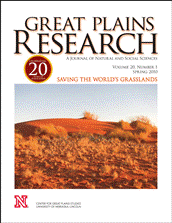Center for Great Plains Studies

Great Plains Research: A Journal of Natural and Social Sciences (through 2013)
Date of this Version
Spring 2005
Document Type
Article
Abstract
Despite its title, this book is more about advice to Public sector authorities on how to plan housing and industrial developments in agricultural regions than about "conserving biodiversity in agricultural landscapes." The hook presents models of "nature-based planning" and assumes that in jurisdictions where legislated planning mechanisms are absent, biodiversity is automatically threatened. It is a book for those who see land use planning as the only answer to difficult landscape issues.
There is little appreciation that most agricultural lands are privately owned and inhabited by people who subscribe to the values and cultural norms or agrarian societies. These societies place constraints on personal behavior while at the same time clinging fiercely to the independent traditions that built them in the first place. Suggestions on how to "plan" development in such "cultures" is notably absent.


Comments
Published in Great Plains Research Vol. 15, No. 1, 2005. Copyright © 2005 The Center for Great Plains Studies, University of Nebraska–Lincoln. Used by permission.